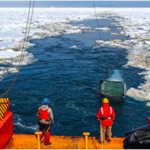A Captain’s Journey to the Antarctic
In the seas of Antarctica, nothing is assured. The weather is fickle, changing from sunny skies to whiteouts in the blink of an eye. Ice is not just ice—it forms in bergs, floes, pancakes, and sheets, each one distinct from the other. For seafarers from half a world away, these obstacles make it a tricky place to travel, and the uncharted seafloors mean extra caution and experience are needed to explore the extreme environment and make it safely back home.
Ernest Stelly sits at the helm of one of the few vessels that supports scientific research in the oceans of Antarctica. From the captain’s chair on the bridge of the ARSV Laurence M. Gould he surveys the path ahead, noting the thickness of ice, nearby icebergs, and the wind. In a flat brimmed Dallas Cowboys hat, gold chains around his neck, and a cigar at his lip he is a man of style, and not necessarily what you’d imagine at the wheel of an expedition to the bottom of the world. But the individuals who have worked with him over the years trust him with their lives. Decades of working in Antarctica means Stelly has an innate knowledge about safely navigating the treacherous waters, ensuring all on board are safe, from the engineers to the scientists conducting experiments from the stern of the ship’s deck.
“Ernest has this incredible intuition that I’m sure he’s developed because he’s been there for so long. He has just an incredible ability to weigh the risks and the rewards associated with the various demands that people place on him,” said Dr. Bill Fraser, who has sailed on the Gould for decades while conducting research on the ecology of seabirds.
Full article at Smithsonian



 This site was developed with the support of the National Science Foundation under Grant No. OPP-2224611 and OPP-2026045. Any opinions, findings, and conclusions or recommendations expressed in this material are those of the authors and do not necessarily reflect the views of the National Science Foundation.
This site was developed with the support of the National Science Foundation under Grant No. OPP-2224611 and OPP-2026045. Any opinions, findings, and conclusions or recommendations expressed in this material are those of the authors and do not necessarily reflect the views of the National Science Foundation.
